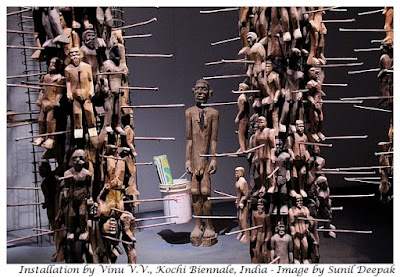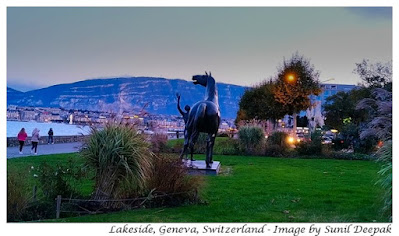2019 was full of journeys for me, from Philippines in the east to Brazil in the west. This post is to remember the most significant moments of my travels. The first picture (below) is from a wonderful journey across Kerala and Karnataka in India - from the Chennakeshava temple in Belur. (Click on the images for a bigger view)
There was a time, when I did a lot of international travel. Then over the past decade, my travelling had gradually decreased, though I still continued to visit 3-4 countries every year. However, in 2019, a number of events came together, creating greater opportunities for my travel.
Travels in India
I started 2019 by travelling to Delhi in January. During this visit, I decided to explore the expanded network of the Delhi metro. For example, one day I went to search for the Dalit Pride Park in NOIDA. On my way back, I stopped in Jamia Milia and went to visit the tomb of Dr Zakir Hussain (in the image below), who was the President of India during 1967-69.As a child, I had met Dr. Hussain and the well-known artist M.F. Hussain at Triveni Kala Sangam in Delhi and had vivid memories of that meeting. I was curious to visit his tomb.
In January, I also went to Kerala, where in Fort Kochi I visited the Kochi Art Biennale 2018-19. The image below presents an installation by Venu V. from the biennale.
I travelled in trains and buses along the Kerala coast, going from Kochi to Mangalore and then to the town of Hassan in Karnataka. From Hassan, I visited the amazing temples of Halebidu and Belur. The first image at the top presents one of the amazing women sculptures from the Chennakeshava temple in Belur.
Back in Delhi in February, I visited the recently rennovated Sundar Gardens near Hamayun tomb. The image below shows Sundar burj from these beautiful gardens.
Back in Delhi in February, I visited the recently rennovated Sundar Gardens near Hamayun tomb. The image below shows Sundar burj from these beautiful gardens.
February was also an opportunity to visit the street art in Lodhi colony, about which I had heard a lot. It was the time when some artists were visiting the city to make new murals, so during my next visit to Delhi, I am planning to visit this area once more to see the new additions.
In March, we had a family visit to the Kumbh mela in Prayagraj (Allahabad). My cousin sister had passed away suddenly and our visit included a ceremony for dispersing her ashes at Sangam, where river Ganges meets Yamuna. This visit was also an opportunity to visit and meet persons from our extended family and our old family home, before coming back to Delhi and concluding my India visit.
Milan, Italy
Back in Italy, in early April, I was part of a conference in Milan. This was an opportunity to explore the Naviglio canal. I had been there many years ago and remembered it as an old and decaying area. With the cleaning of Naviglio, the whole place has changed completely. Now it is full of tourists visiting crowded restaurants and new glittering shops.Liberia
In the last week of April, I was back in Monrovia, the capital of Liberia. There is not much to see in Monrovia and security concerns make it difficult to go out. I also had to run a training course, so there was not much free time. However, one early morning, before the starting of the training, I did manage a walk along the seaside.I also travelled for a day to Ganta in Nimba county to meet some old friends. They are trying to build up a wild life sanctuary in Liberia. May be in future, one day there will be places to visit here.
During the second visit, in October, we visited some provinces around Ulaanbaatar. One of the visits was to Arkhangai and on the way, we stopped to see the Buddhist monastery at Korakorum, the old capital of Mongolia during the times of Gengiz Khan (in the image below). It was a place that I had dreamt of visiting one day and the visit was really great.
Mongolia
I visited Mongolia twice in 2019. The first time at the end of June when I stayed in Ulaanbaatar and did not travel to other places. However, I did go out for different walks to discover the city, such as a walk to look at the sculptures of a camel caravan.During the second visit, in October, we visited some provinces around Ulaanbaatar. One of the visits was to Arkhangai and on the way, we stopped to see the Buddhist monastery at Korakorum, the old capital of Mongolia during the times of Gengiz Khan (in the image below). It was a place that I had dreamt of visiting one day and the visit was really great.
Brazil - Campo Grande and Niteroi
In August I was in Brazil for a couple of weeks, first in Campo Grande and then in Niteroi, near Rio de Janeiro. In between my work commitments, I had plenty of time to go around for walks in Brazil. In Rio de Janeiro, a short ferry ride away from Nietroi, I went to different museums but my most precious experience was visiting an Ai Wei Wei art exhibition.Niteroi is a wonderful place to stay with some of the most beautiful views of the Bay of Guanabara and the amazing skyline of Rio de Janeiro (in the image below).
Manila, Philippines
Back from Brazil and with a short break of a few days, I had to go Manila for a conference. The 12 hours time difference from Brazil, made this visit very difficult for me. I tried everyday to walk and discover parts of Manila that I had not seen earlier. Thus, I joined the visit organized by our conference hosts to visit Intramuros, the Spanish part of Manila (Fort Santiago in the image below).Istanbul, Turkey
In October, on my way back from Mongolia, I stayed overnight in Istanbul. I have passed through Istanbul airport many times, but had never stopped there and was hoping to visit the city. However, during my one day of stay, it was raining most of the time and thus, I was forced to stay in my hotel room. The image below was clicked from the bus going back to the airport. I hope to have another opportunity to visit Turkey in the new year.Geneva, Switzerland
Between August to October, I had travelled so much that I became unwell and had to cancel a visit to Spain. I had also made plans for a family gathering in the USA, but I was so tired of travelling that I cancelled it.The only journey outside Italy I made was to Geneva for a meeting at the World Health Organisation in mid-November. Even during the brief stay, I found some time to go for a walk along the left bank of the Leman lake, which I like very much (image below). Unfortunately, there was not enough free time to visit the botanical gardens, another of my favourite places in Geneva.
Italy - Padova, Treviso & Venice
Veneto region of Italy, where I live, is full of beautiful little medieval towns. This year, I visited some of them such as Castelfranco Veneto, Padova, Treviso, Thiene and Vicenza (below an image from the Padova Pride parade).In November, I also managed to visit the Venice Art Biennale before it ended. It had a couple of installations that I had seen in Kochi art biennale in the beginning of the year. The image below shows the visually striking giant installation by Lorenzo Quinn from this Biennale.
Conclusions
I am glad that I could visit so many countries during 2019, though I overdid it! My new year resolution is to have fewer work commitments in other countries in 2020, so that I can enjoy my travels more.Already my bags are packed and I am preparing to go back to India. I want to conclude this post with an image from the street theatre perforamnce by students of Aurobindo college in Delhi, which I had seen during my last visit to Delhi - the play was about the vanishing languages of India and was called "Zubaan sambhal ke". I like street theatre plays very much and am hoping to catch some of them during my visit.
One new development in 2019 was my increasing use of phone-cameras, instead of my usual Canon DSLR. This explains the different sizes and qualities of the pictures used for this post. Carrying a mobile to click pictures is so convenient and I think that in 2020, I will use it even more.
*****



























































